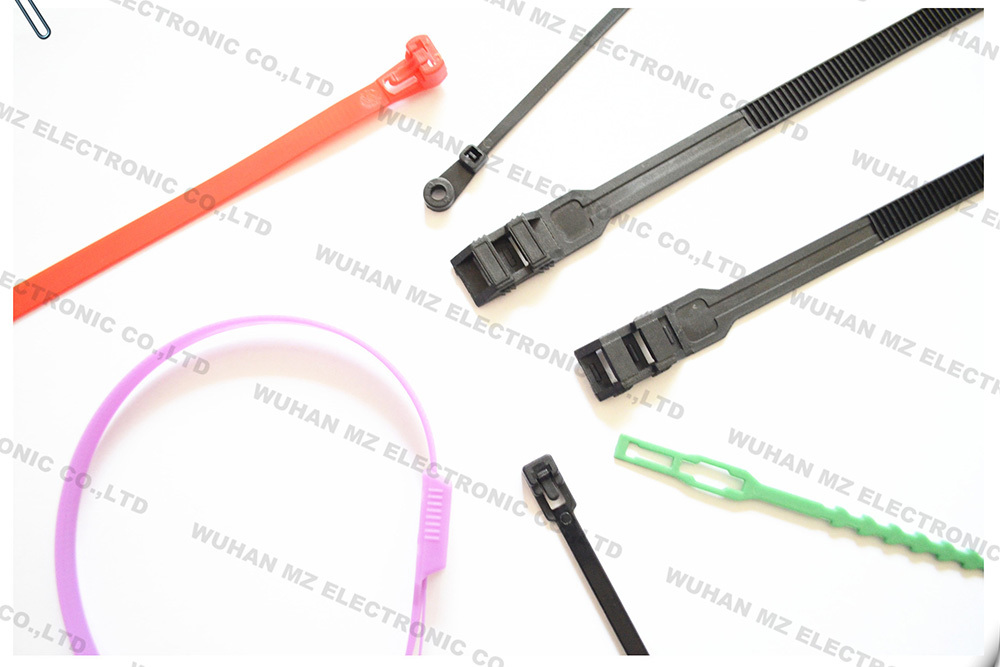30
2025
-
10
Analysis of the Cost Performance of Plastic Cable ties
Author:
Material Composition and Performance Impact
The core material of plastic cable ties determines their durability and application scope. Nylon (polyamide) variants, such as PA6 and PA66, are widely regarded for their high tensile strength, chemical resistance, and ability to withstand temperatures ranging from -40°C to 85°C. These materials are commonly used in industrial settings, automotive wiring, and outdoor installations due to their resilience against UV exposure and moisture. In contrast, polypropylene (PP) ties, while cost-effective, exhibit lower tensile strength and higher elongation rates, making them suitable only for lightweight, temporary bundling tasks like securing packaging or organizing household items.
For specialized environments, engineered plastics like Z63 offer enhanced properties. This material reduces water absorption by six times compared to standard nylon, minimizing performance degradation in humid conditions. Its resistance to acids, salts, and oils also makes it ideal for marine, chemical, or automotive applications where traditional nylon may fail. Users must align material choices with environmental demands—opting for PP in dry, low-stress scenarios and nylon or Z63 for harsh, high-load contexts.
Structural Design and Functional Efficiency
The physical design of cable ties directly influences their usability and reliability. Self-locking mechanisms with serrated teeth are critical for secure fastening; poor tooth engagement can lead to slippage under tension. High-quality ties feature uniformly spaced teeth that grip the strap tightly without requiring excessive force during installation. Additionally, the flexibility of the strap matters: premium nylon ties can bend repeatedly without cracking, whereas rigid PP ties may develop stress fractures over time.
Width and thickness also play a role. Wider ties distribute stress more evenly, reducing the risk of breakage when bundling thick cables or heavy objects. For example, a 7.6mm-wide nylon tie can secure multiple wires or pipes, while narrower PP ties are limited to lightweight tasks. The locking head’s durability is another consideration; robust designs resist deformation when pulled, whereas flimsy heads may snap during tightening.
Environmental Adaptability and Longevity
Exposure to environmental factors significantly impacts the lifespan of plastic cable ties. UV radiation degrades PP ties rapidly, causing brittleness and discoloration within months. Nylon ties, especially those with UV stabilizers, maintain flexibility and strength for years under direct sunlight. In cold climates, low temperatures can make PP ties brittle, increasing the likelihood of breakage during installation or use. Nylon, however, retains its toughness even in sub-zero conditions, making it preferable for outdoor winter applications.
Chemical exposure is another critical factor. PP ties may swell or degrade when in contact with oils, solvents, or acids, limiting their use in industrial settings. Nylon ties, particularly those treated with chemical-resistant additives, resist corrosion and maintain structural integrity in such environments. For instance, ties used in automotive engine compartments or chemical storage areas must withstand prolonged exposure to fuels and cleaners without compromising performance.
Application-Specific Considerations
Selecting the right cable tie involves evaluating the specific demands of the task. For household organization, such as managing cables behind desks or bundling holiday lights, a standard nylon tie with moderate width and UV resistance offers sufficient durability. In contrast, industrial applications, like securing hydraulic hoses or electrical conduits in construction sites, require heavy-duty ties with reinforced locking mechanisms and high tensile ratings.
Outdoor projects, such as garden trellising or securing irrigation systems, demand ties resistant to moisture, UV light, and temperature fluctuations. Here, nylon or Z63 ties outperform PP alternatives due to their weatherproof properties. For temporary or disposable uses, like packaging or event setups, cost-effective PP ties may suffice, provided they are not exposed to harsh conditions.
Maintenance and Reusability Factors
The longevity of cable ties also depends on maintenance practices. Reusable ties with adjustable locking mechanisms allow for modifications without cutting, reducing waste in dynamic environments like workshops or data centers. However, most standard ties are single-use, requiring careful planning during installation to avoid over-tightening, which can damage cables or the tie itself.
Regular inspection of ties in critical applications, such as automotive wiring or aerospace components, is essential to identify signs of wear, such as cracks or loosening. Replacing compromised ties promptly prevents system failures. Additionally, storing ties in a cool, dry place away from direct sunlight preserves their material properties, extending their shelf life before use.
plastic cable ties
Hot News
2025-10-31
Selection of corrosion resistance performance of plastic cable ties
The corrosion resistance of plastic cable ties is primarily determined by their polymer base and additive formulations. Polyamide 66 (PA66), a common material for industrial ties, exhibits moderate resistance to hydrocarbons, oils, and weak acids. However, its performance diminishes in the presence of strong acids, bases, or chlorinated solvents. To enhance durability, manufacturers incorporate stabilizers such as hindered amine light stabilizers (HALS) and UV absorbers, which prevent degradation from environmental stressors.
2025-10-31
Selection of fire resistance performance for plastic cable ties
The fire resistance of plastic cable ties is primarily determined by their material composition and certification standards. The most widely recognized metric is the UL94 flame rating system, which categorizes materials based on their burning behavior. For instance, ties labeled as UL94 V-0 exhibit superior fire resistance compared to V-2 rated variants.
2025-10-30
Environmental protection requirements for plastic cable ties
Global environmental regulations have significantly tightened restrictions on hazardous substances in plastic packaging materials, including cable ties. The Toxic Packaging Clearinghouse (TPCH) in the United States updated its model legislation in 2025, imposing strict limits on harmful chemicals.
2025-10-30
Analysis of the Cost Performance of Plastic Cable ties
The core material of plastic cable ties determines their durability and application scope. Nylon (polyamide) variants, such as PA6 and PA66, are widely regarded for their high tensile strength, chemical resistance, and ability to withstand temperatures ranging from -40°C to 85°C.

